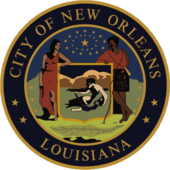Frenchmen Street
Frenchmen Street is in the 7th Ward of New Orleans, Louisiana. It is best known for the three-block section in the Faubourg Marigny neighborhood which is home to some of the city's popular live-music venues[1] including Cafe Negril, Blue Nile, Snug Harbor, the Spotted Cat, and the Maison in addition to restaurants, bars, coffee shops, record and book shops, and other local businesses.

Location
Frenchmen Street runs from the intersection with Esplanade Avenue just inland from the Mississippi, back to the Gentilly neighborhood.
History
The oldest and best-known section of Frenchmen Street is in the Faubourg Marigny neighborhood, just downriver from the Vieux Carré or French Quarter. This area was once the plantation of Bernard de Marigny, a wealthy Creole and political leader of old New Orleans. He exemplified the Creoles of his day, with his joie de vivre — a keen enjoyment of living. In 1806, he had his property subdivided and developed as a neighborhood. Many of the houses in this area are over 100 years old; some are much older. Frenchmen Street got its name from "six French men who were executed after leading an uprising after Louisiana was ceded to Spain."[2]
The Frenchmen Street entertainment district began developing in the 1980s. As Bourbon Street became more tourist-focused, Frenchmen emerged as a spot for locals to enjoy live local music, as it was more geared toward authentic New Orleans musical and gastronomical tastes.
Residing on some of the highest ground in the city, Frenchmen Street survived Katrina relatively unscathed. Following the catastrophe, the street was officially designated a city arts and entertainment district; its popularity increased when it was patronized by people who came to New Orleans to help rebuild, and by visitors who sought authentic local music.
After the Saints' Super Bowl win in 2010, the street received national news media coverage for hosting one of the largest celebrations in the city's history. Frenchmen Street was also featured on the HBO series Tremé.

Architecture
Wandering down Frenchmen Street, a passerby will notice the New Orleans architecture that makes the city stand apart from other American metropolitan areas. Frenchmen Street is home to many Creole cottages—a New Orleans design stemming back to the period between 1790-1850. Creole cottages are single-story, set at ground level, have a steeply-pitched roof, symmetrical four-opening façade, and are set close to the front property line. The cottages are usually made of stucco or wood. In the “French Quarter Manual,” architect Benjamin H. Latrobe described the cottages: “These one-storied houses are very simple in their plan. The two front rooms open into the street with French glass doors. Those on one side are the dining & drawing rooms, the others, chambers. The front rooms, when inhabited by Americans, are the family rooms, & the back rooms the chambers.”[3]
Frenchmen Street also has a number of examples of another New Orleans-style home, the Creole townhouse. This style dates from 1788, following the Great New Orleans Fire. The Creole townhouse is a two- to four-story structure set at or near ground level, with a symmetrical arrangement of arched openings on the façade, set on the property line, an iron balcony at the second and sometimes third levels, and a steeply-pitched, side-gabled roof, often with multiple dormers. It usually has a stucco or brick exterior.
See also
References
- "New Orleans Online".
- experienceneworleans.com http://www.experienceneworleans.com/news/new-orleans/nola-street-names. Retrieved 9 October 2019. Missing or empty
|title=(help) - Benjamin Henry Latrobe, Impressions Respecting New Orleans, Diary & Sketches, 1818-1820.
External links
| Wikimedia Commons has media related to Frenchmen Street. |
![]()
